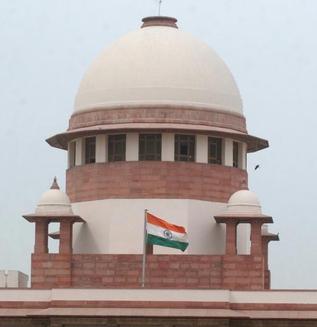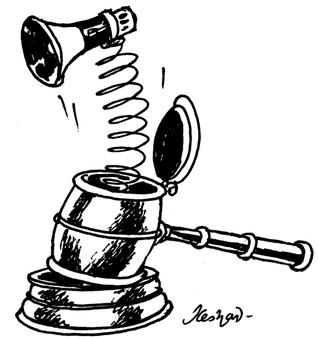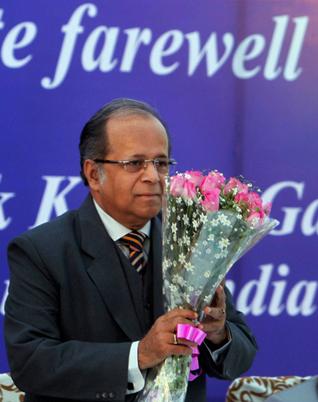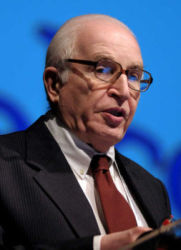PUBLISHED IN THE INDIAN EXPRESS
Full text of Justice Ranjan Gogoi’s speech at RNG Memorial Lecture:
I express my most heartfelt gratitude to The Express Group for extending this opportunity to me to deliver the lecture which has been organised in the memory of a man who was an institution in his own right: Ramnath Goenka ji.
While unlike some of you present here, I had not had the occasion to ever meet him, but, fortunately I have not been untouched by his proud legacy. Which gleams through that what he had founded as an answer to Gandhi ji’s call to start a swadeshi newspaper. Living in the realm of the Raj, it needed an iron-will and iron man and we found it in a young Ramnath ji. His legacy also gleams through the rich jurisprudence on the Freedom of the Press that he was instrumental in moulding, and which, by virtue of my Office, I work every day. It needed a committed and a cause-driven litigant – a rarity which it is nowadays – and we found it, yet again, in Ramnath ji. During the dark days of the Emergency, he stood as an unwavering gatekeeper of those fundamental liberties that we hold so dear today and that is his legacy too.
PART 1:
Today, after all these years, some remember him as the ‘Warrior of the Fourth Estate’ 1 , some remember him as a “dogged, unyielding adversary” 2 , some remember him as an “iconoclast”, some as a “magnificent rebel”. He was, at times unapologetic, at times uninhibited, at times even contradictory, but forever fierce, forever feisty, and forever fearless. His entire life trajectory from Darbhanga to Madras to Bombay; from the Constituent Assembly to the Newsroom to the Courtrooms, is a test case of its own kind that we, perhaps, need to use more often in our lives, in our institutions. Not too long back, I had read an interesting news article talking about the surprising surge – which is not so surprising, all things considered – in the sale of George Orwell’s 1984 in the United States. That piqued my interest in revisiting the classic. And, for some reason, I want to recollect a thought from it today. “Freedom is the freedom to say that two plus two make four. If that is granted, all else follows.”
 Abhishek Manu Singhvi of the Congress party along with former finance minister P Chidambaram at the third Ramnath Goenka Memorial Lecture in New Delhi. (Express Photo by Abhinav Saha)
Abhishek Manu Singhvi of the Congress party along with former finance minister P Chidambaram at the third Ramnath Goenka Memorial Lecture in New Delhi. (Express Photo by Abhinav Saha)
If I had to put it very simply, for me, this is what Ramnath ji stood for. The freedom to say that two plus two make four. And, that is how I remember him as. Someone who could call Spade a Spade. Someone who could speak truth to power. Even if it came at a cost. To be ready to break, but not bend could be called obstinacy by some, and determination by others. Is it a matter of perspective? I do not know. And, I cannot say for others but as far as I am concerned, I only feel that we need to ask ourselves some questions: Where is the Goenka in us; his ideals; his values? Is that extraordinary phenomena losing his relevance today, after all these years? Why I have chosen the topic for this discourse merits a context too. And, this is the context. These are some sore questions, but too significant to get lost in the everydayness. And, when it is so, what other better tribute can there be to a visionary who embodied in so many ways the spirit of our Constitution, than to spend a thought. To spend a thought over how far we have come to achieve the vision that he had seen as someone who helped free the country in one era, and helped it become a meaningful Democracy in another.
PART 2:
I will use a few minutes to put across my proposition as to what I intend to say when I talk about the “Vision of Justice”. I will borrow from the Chief Editor Shri. Raj Kamal Jha himself, because it offers a very fine perspective. Very powerfully and thoughtfully and rightly, he said of Ramnath ji in one his letters to me, that, “fierce independence” and “enduring sense of inquiry without fear or favour” were the two values that Ramnath ji believed formed the “bedrock of Justice”. It is absolutely incontestable that they do and, for convenience, let me call them the Bedrock Principles. But, if I were to look at it anatomically, while these do indeed form the bedrock of Justice, what is the Form/Body of the ideal called Justice which rests on this bedrock? The Bedrock Principles have been the talk of the town lately considering how the entire thinktank is so keenly focused on it. And I am not suggesting that it ought not to be. It ought to be done and it is being done. I cannot recall the last time, the Judicial wing of the State made so much news. On a lighter note, let us recall, Hamilton (the American Founding Father) who had suggested that the Judiciary was the least dangerous branch of the State’s three branches – and I will refer to him again during the course of my address – but, were he to be here today, I wonder if he would have felt the same way. More so, in the light of the IE Top 100 Most Powerful Indians which included several names from the judiciary. But, the fact of the matter is that if we have to take stock of how we have fared – and about seven decades later since we ventured into becoming a Constitutional Order, this appears to be an opportune time to do so – we might as well do it comprehensively. And, by comprehensively what I mean is that we must evaluate both the Bedrock Principles and the Form Principles because the Vision of Justice, the way I understand it, is a compound of both. Clearly, they are not unconnected. And over the course of next about half an hour, I will attempt to touch upon both. I will begin with the Form Principles, and bear with me, in order to drive home my point, I may have to get somewhat academic.
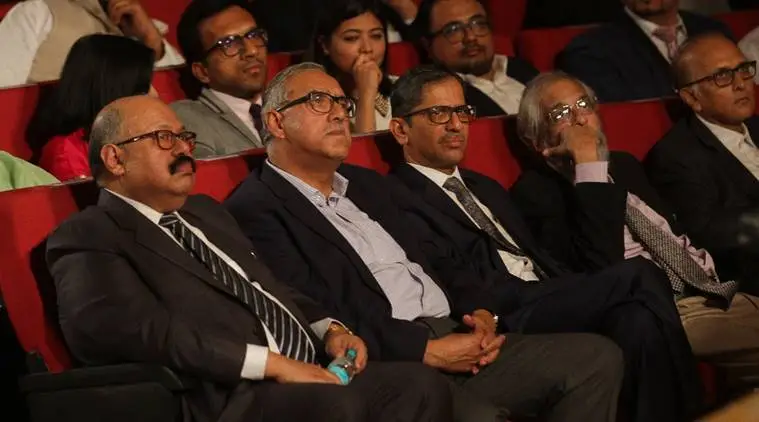 From (L-R): Hrishikesh Roy, Chief Justice, Kerala High Court, Deepak Gupta, Judge, Supreme Court, N V Ramanna, Judge, Supreme Court, Madan B Lokur, Judge, Supreme Court at the third Ramnath Goenka Memorial Lecture. (Express Photo by Abhinav Saha)
From (L-R): Hrishikesh Roy, Chief Justice, Kerala High Court, Deepak Gupta, Judge, Supreme Court, N V Ramanna, Judge, Supreme Court, Madan B Lokur, Judge, Supreme Court at the third Ramnath Goenka Memorial Lecture. (Express Photo by Abhinav Saha)
You will agree, that in the backdrop of a bleeding mega partition, deeply entrenched inequities, perpetuating injustices, our Constitution ushered us into believing in a grand promise of transformation on a scale that was beyond reformatory. It was, in all its full glory, a revolution in all aspects of life – social, economic, political. In a way, it said, let bygones be and the new society that we would be, would be egalitarian. While preserving our pluralistic character, we would be democratic and united too. The State would be religion-neutral, the citizens equal and together. Coming to think of it, it was just as pretentious as it was unpretentious an idea. But be that as it may, public institutions (one of them being the Judiciary) were inherited, they were tweaked where need was felt, to give life to this prodigious architecture of Justice. And, here, I would like to clarify that by justice, I am not implying only the juridical connotation of the word which is the administration of justice by the courts of law – although it is just as imperative – but justice is something that is an overarching principle, an underlying fundamental, the spirit, an order so to say. Which is why I say “prodigious”.
PART 3:
Because, it was a confluence of very many philosophies – [1] the Aristotelian, for instance, which suggests that the very essence of the State is justice which according to the philosopher was a social virtue; good of others; equality and fairness. When we peruse the Preamble to the Constitution- our vision document – is it not that this ideology is enshrined in the words “Equality of status and opportunity”? [2] Or, the Utilitarian philosophy of John Stuart Mill whose view was that justice was the greatest good to the greatest numbers. In the Preamble, is this not enshrined in the principles of “Socialism”, and “Equality” yet again? [3] Or, the relatively more modern one: the Rawlsian perspective which is that justice as fairness is the most egalitarian and also the most plausible concept of liberalism. In the Preamble, is this not reflected in the words “Liberty of thought, expression, belief”. So, the Preamble, if you deconstruct it precept-wise, is the very embodiment of these ideas. Justice is not something that is a standalone precept but an amalgam of other ideals like “socialism”; “democracy”; “liberty”; “equality”; “fraternity”, to name a few. They are not isolated silos because their undying endeavour is to establish one discipline – of overall justice, of an inclusive society. And, this is exactly what I meant by the Form Principles of Justice as an ideal. As a composite unit called Justice, these had been intended to be achieved by the Legislature, the Executive and the Judiciary.
 Justice is not something that is a standalone precept but an amalgam of other ideals like “socialism”; “democracy”; “liberty”; “equality”; “fraternity”, to name a few — Justice Gogoi in his address. (Express Photo by Tashi Tobgyal)
Justice is not something that is a standalone precept but an amalgam of other ideals like “socialism”; “democracy”; “liberty”; “equality”; “fraternity”, to name a few — Justice Gogoi in his address. (Express Photo by Tashi Tobgyal)
Now, it will make for an incredibly interesting and if I may add overwhelmingly contentious tale to tell as to how the Executive and the Legislature have performed on this front. But the scope of my discourse will be limited to the judiciary’s endeavour in this regard. A few months back, I had the occasion to deliver the Justice P.D. Desai Memorial Lecture, at Ahmedabad. And, there I had proposed that attaining Constitutional Idealism was not like chasing a rainbow and the Supreme Court, through its pronouncements, had been reflecting it. It would not be a display of the pessimism of the intellect today, if I were to say that while, indeed, attaining Constitutional Idealism (= Vision of Justice) is not like chasing a rainbow, but, it is so only in the courtrooms. Perhaps, because fields are where the rainbows are (“fields” being the operative word). The point being that the way nation is built and the way this grand Vision of Justice is attained in the confines of the courts through judicial pronouncements and the way they are built on the ground are two very disparate realities. Agreed, the aspirational aspect of the Constitution and the operational aspect of the Constitution will always be two different notions. The aspirational aspect is high idealism of a kind that is almost moralistic and preachy. The operational aspect has to do with the very strange realities of the ground, almost defeating. But then even if we may be slow to move to bridge the gap between the two, which itself is not an acceptable compromise either, but we must, at the least, not become retrograde.
 Justice Ranjan Gogoi: The judgments beyond their bare letter, say that, societal morality is fickle and not that, but constitutional morality that ought to dictate terms. (Express Photo by Tashi Tobgyal)
Justice Ranjan Gogoi: The judgments beyond their bare letter, say that, societal morality is fickle and not that, but constitutional morality that ought to dictate terms. (Express Photo by Tashi Tobgyal)
Take for example the 2015’s ruling in Shreya Singhal v. Union of India 3 (2015). It is a celebrated judgment, where the Supreme Court held that the public’s right to know was directly affected by Section 66A. Interestingly, while doing so, the Court was certainly inspired by, amongst other rulings, Romesh Thappar v. State of Madras 4 (1950); Brij Bhushan v. State of Delhi 5 (1950); Bennett Coleman & Co. v. Union of India 6 (1973). If you would recall, these were perhaps some of the earliest pronouncements protecting an Independent Indian’s Speech and Expression and were delivered in the light of the rights of the Press, which verdicts themselves had endorsed that a democracy was a marketplace of ideas where the people had a right to know; that prior restraints were anathematic to a democracy and that the freedom of speech and of the press is the Ark of the Covenant of Democracy. Shreya Singhal took this legacy ahead as it improved upon the jurisprudence on the independence of the Press to attain and promote the Constitutional precept of plurality of thought, diversity of opinion and the ethos of democracy in the tech-age and in the context of online speech. The Vision of Justice was indeed attained in the courtroom. Not once, but multiple times. But has it translated into reality? Has the success of these sterling verdicts reached the ground? I will let the facts speak for themselves. On the ground, it is a descent into chaos. And it is worrisome on all counts when you sue the messenger or when you shoot the messenger, or when the messenger itself declines to deliver the message because of the fear psychosis. On the 19 th June, The Indian Express had published a very insightful article (selected from The Economist) titled as ‘How Democracy Dies”.
 From (L-R): Acting Chief Justice of Delhi High Court Justice Gita Mittal, Former Law Minister Ashwani Kumar, CPI leader D Raja and jurist Soli Sorabjee at the third Ramnath Goenka Memorial Lecture. (Express Photo by Abhinav Saha)
From (L-R): Acting Chief Justice of Delhi High Court Justice Gita Mittal, Former Law Minister Ashwani Kumar, CPI leader D Raja and jurist Soli Sorabjee at the third Ramnath Goenka Memorial Lecture. (Express Photo by Abhinav Saha)
It said, at one place, that, “…independent judges and noisy journalists are democracy’s first line of defence…Reports of the death of democracy are greatly exaggerated. But, the least bad system of government ever devised is in trouble. It needs defenders.” I agree but will only suggest a slight modification in today’s context – not only independent judges and noisy journalists, but even independent journalists and sometimes noisy judges. While Shreya Singhal was significant in its own right, NALSA v. Union of India 7 breathed new life into the Equality principle. The Court understood that our Founding Fathers’ vision about fundamental right against sex discrimination was to prevent differential treatment as a result of one’s not conforming to generalizations. The judgment made a momentous foray into the fountain-head of dynamism. And, I will get back to it but before I do that, I must touch upon a very fascinating judgment of 1986 vintage called Bijoe Emmanuel v. State of Kerala 8 . This was a case where three Jehovah’s Witnesses had refused to sing the National Anthem (as their tenets dictated so) when it was being sung in their school. They did stand up though. Nevertheless, they were expelled from the school. When the case found its way to the Supreme Court, while holding that the expulsion would be in violation of their Fundamental Right to ‘freedom of conscience’, the Court observed that “the real test of a true democracy is the ability of even an insignificant minority to find its identity under the country’s Constitution.”
 Former Chief Justice of India Rajendra Mal Lodha (Express Photo by Abhinav Saha)
Former Chief Justice of India Rajendra Mal Lodha (Express Photo by Abhinav Saha)
The court also felt the need to add a thought. And, I feel compelled to quote it. It is the penultimate line of the verdict and it says – “our tradition teaches tolerance; our philosophy preaches tolerance; our Constitution practices tolerance; let us not dilute it.” Recently. in Adi Saiva Sivachariyargal Nala Sangam v. Government of Tamil Nadu 9 , the Court held that even in the matters of religious beliefs, constitutional legitimacy cannot be foregone and following Justice B.K. Mukherjea in Shirur Mutt case (of 1954), went on to hold that it is not the State or the religious Indian but the Constitutional Court which decides on what constitutes essential practices of any particular religion.
Some of you could be wondering about how these judgments are even related. They are not. But, they are, at the same time. Dissimilarity is that the first one originates in a very intimate, private sphere of life and the other two originate in what everybody seems to want to have a say in – the matters of faith. But, it is the similarity that should be the take away. The judgments beyond their bare letter, say that, societal morality is fickle and not that, but constitutional morality that ought to dictate terms. As an Israeli judge Aharon Barak points out, it is not the transient spirits of time but the fundamental values that should be the guiding voice 10.
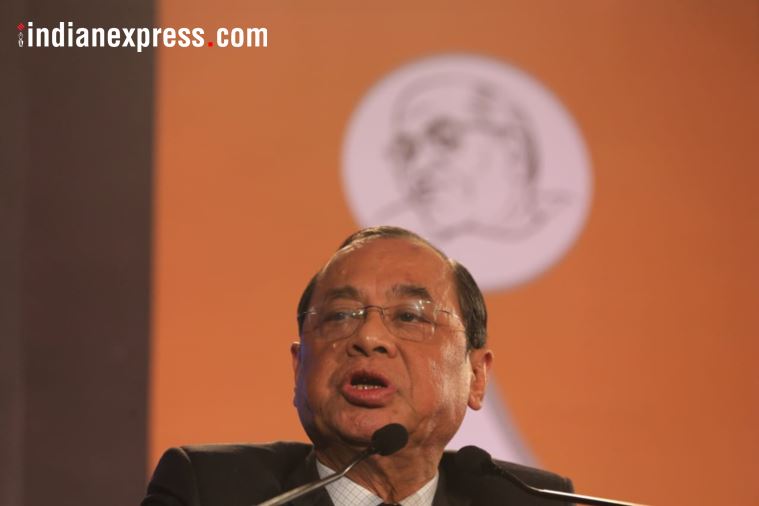 In a way, it said, let bygones be and the new society that we would be, would be egalitarian. While preserving our pluralistic character, we would be democratic and united too. (Express Photo by Tashi Tobgyal)
In a way, it said, let bygones be and the new society that we would be, would be egalitarian. While preserving our pluralistic character, we would be democratic and united too. (Express Photo by Tashi Tobgyal)
In his last address to the Constituent Assembly, Dr. Ambedkar had said that we must not only be a political democracy but a social democracy as the former cannot last unless lies at the base of it the former. And, social democracy, he defined, as a way of life which recognises liberty, equality, fraternity as one principle. I wouldn’t want to wade into knowing if we are a successful political democracy, but, I do, earnestly believe, that we are a social democracy, in all aspects. But again, largely jurisprudentially. And the disparity is there because the two Indias – both just as perceptible – are at conflict. There is an India that believes that it is the New Order and there is an India that lives below a ridiculously drawn Poverty Line on daily wages in night shelters with no access to education or healthcare, let alone access to the Courts of Law. The ambivalence is intriguing. And, this is exactly what I call as getting lost in translation. One India in the aforementioned perspective is the Vision and to know how far we have succeeded in attaining this Vision of Justice is really a matter of perception. But nevertheless, there is a graphic disparity right there and removing this disparity will be the mission for the Indian Judiciary in the times to come. And if I may add, for that to happen, it is going to require a “constitutional moment” of its own kind in the life of this institution, which I believe has been long overdue.
 “I will only say that if it wishes to preserve its moral and institutional leverage, it must remain uncontaminated,” says Justice Gogoi. (Express Photo by Abhinav Saha)
“I will only say that if it wishes to preserve its moral and institutional leverage, it must remain uncontaminated,” says Justice Gogoi. (Express Photo by Abhinav Saha)
The Constitutional history with reference to this institution as a whole (and, especially the Supreme Court) would show that its own role has constantly evolved in the light of the socio-political context. If 1970-1980 was the decade where it expounded the Basic Structure Doctrine, in 1980s, it constantly expanded the scope of Article 21 and by 1990s, it became somewhat of a “Good Governance Court” by innovatively interpreting Constitutional provisions to address the inadequacies consequent upon executive and legislative inactivity. In the first fifty years since our independence, the court has created a very sound jurisprudence which we continue to reap from. It is the inertia really that has kept us going till now. But the way things stand today, court processes are a trial even before the trial has begun. While I cannot say if it is a collective failure on our part but for a nation governed by the rule of law, is it not a matter of concern that to this extent at least, we are defying the idea of inclusiveness? Not a reform but a revolution is what it needs, to be able to meet the challenges on the ground and to keep this institution serviceable for a common man and relevant for the nation. For the effectiveness of the judgments to show, the justice dispensation system has to be made more result oriented i.e. to say, more focused on enforcement. I understand what Mr. Arun Shourie 11 suggests when he wonders if the judiciary is not being an “accessory to the resulting deterioration”, when it in its hopefulness and optimism, doesn’t go after its mandate till its implementation. I find it difficult to agree wholeheartedly. But I will certainly say that the judiciary must certainly be more pro-active, more on the front foot. This is what I would call as redefining its role as an institution in the matters of enforcement and efficacy of the spirit of its diktats, of course, subject to constitutional morality (= separation of powers) again. I will even go ahead to say that the institution, at all levels, needs to become more dynamic in the matters of interpretation of laws. And, this is what I mean to say by a constitutional moment of its own kind. However, it is going to be a tall order both at the micro level and the macro level because both come with their unique sets of challenges.
 Executive Director of The Express Group Anant Goenka (left) presents a sketch to Justice Ranjan Gogoi at the third RNG Lecture in New Delhi on Thursday. (Express Photo by Neeraj Priyadarshi)
Executive Director of The Express Group Anant Goenka (left) presents a sketch to Justice Ranjan Gogoi at the third RNG Lecture in New Delhi on Thursday. (Express Photo by Neeraj Priyadarshi)
By micro level, what I mean is administration of justice on day-to-day basis. Here, the so-called “inefficiency” and “slow processes” have been historical challenges. I will put it very simply. The judiciary today is not a poor workman who blames his tools, but it is a workman with no tools. I am not going to saddle you with the figures that we keep consuming every day on pendency, arrears and judges’ strength but in the light of what a French author had once said, “Everything has been said already, but as no one listens, we must begin again.” 12 , I will only ask and request those at the helm to finally listen so that we must not have to begin again. In addition to that, I also feel that there is a pressing need to explore the endless limits of legal services mechanism. Legal awareness and legal empowerment of the marginalised in this vastly unequal society of ours, have to be a made an observable reality. Let me give you one instance which is glaring insofar as personal liberty is concerned. 67% of the prison population are undertrials, mostly belonging to the underprivileged classes and 47% of them are between the age of 18-30 years. Compare this with the U.K. where it is about 7% and the U.S. which is acknowledged to have a high rate of incarceration where the percentage is 22.7%. The period of about one year that a majority of the undertrials have been in custody would hardly redeem the situation. Will it be wrong to suggest that a fair share of our demographic dividend is being unjustifiably lodged in the jails and mostly for petty or less serious offences?
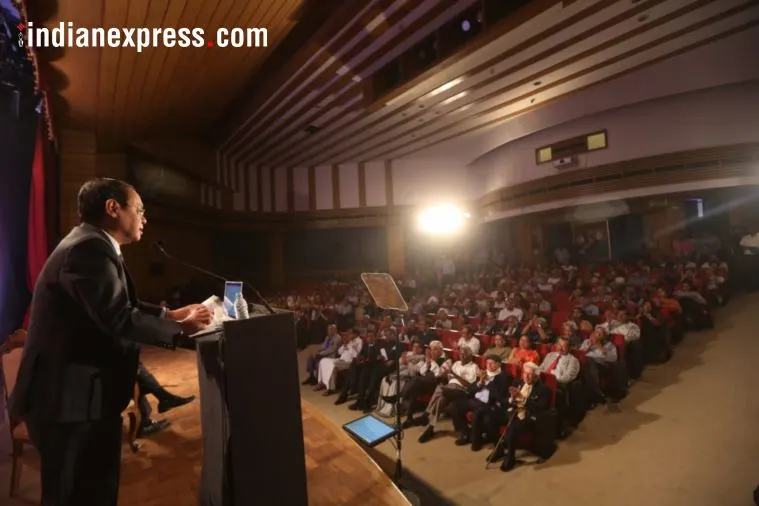 The judiciary, with whatever little it has had at its hand, has been a proud guardian of the great Constitutional vision. (Express Photo by Neeraj Priyadarshi)
The judiciary, with whatever little it has had at its hand, has been a proud guardian of the great Constitutional vision. (Express Photo by Neeraj Priyadarshi)
At the macro level, the judiciary as an institution is being seen as a course corrector, a leveller, a democratiser of sorts. And, since it is too well known that this country is on the cusp of an evolution, naturally it will have implications for this institution just as much. I would like you to recall that I had mentioned about Hamilton in the beginning of the discourse. While contemplating the U.S. Constitution 13 , he had said that the judiciary is the weakest of three branches because it neither has force of the Executive nor the will of the Legislature, but only judgment. This, and which I agree with absolutely, he said, was the “simple view of the matter”. The complex view is this. And which he was wise enough to warn about over two centuries ago. He had said that while the civil liberties will have nothing to fear from the judiciary alone, they will have everything to fear from the union of the judiciary with either of the other two branches.
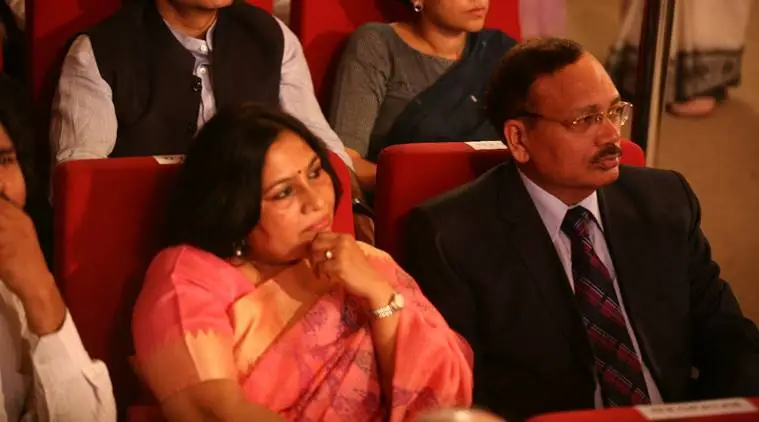 Punjab and Haryana High Court Judge Justice Surya Kant (Express Photo by Abhinav Saha)
Punjab and Haryana High Court Judge Justice Surya Kant (Express Photo by Abhinav Saha)
I would like to believe, this is why, Ramnath ji had also said that “fierce independence” is indeed the bedrock of justice. But I would like to add that “independence” must always be responsible with due regard to established Constitutional values. This institution is the last bastion of hope and the one that the citizenry believes firmly, will give justice to them, come what may. And it has. The judiciary, with whatever little it has had at its hand, has been a proud guardian of the great Constitutional vision. It fills me with immense pride to see that as an institution, the judiciary has been endowed with great societal trust. This very fact gives it its credibility and this very credibility gives it its legitimacy. It is a very enviable spot for an institution. I will only say that if it wishes to preserve its moral and institutional leverage, it must remain uncontaminated. And, independent. And, fierce. And, at all times. A chain is only as strong as its weakest link. So is an institution. And if introspection is where we have to begin, we might as well begin there. Perhaps, we can hope and endeavour that in the future, it is not our finality, but really our infallibility that should define us. It is my imagination of an ideal world and I am aware of what Carl Jung had said of it. He had had said that, “Every form of addiction is bad, no matter whether the narcotic be alcohol, morphine or idealism.” I don’t know how true his view holds on other counts, but as far as idealism is concerned, I would say, it should be pursued like an axiom. Thank you very much.
Jai Hind!


